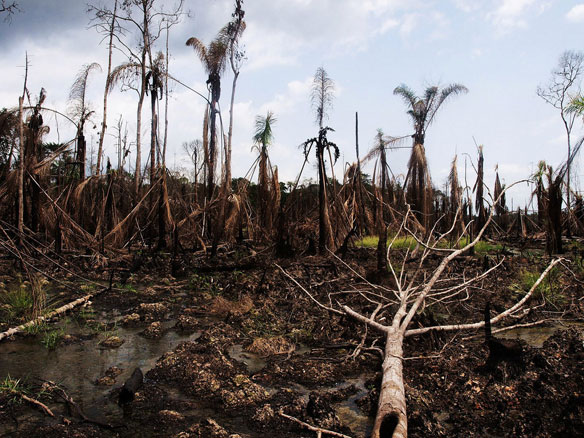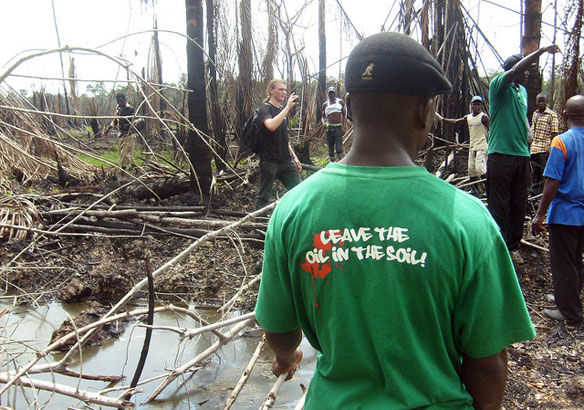
Activists from Enviromental Rights Action in Nigeria explore oil damages in the Niger Delta, April 2010. Caption and Photo source: ©© S.U
Environmental Assessment of Ogoniland: A UN Environment Programme (UNEP) Report
50 years of oil pollution in Nigeria’s Ogoniland region may require the world’s biggest ever clean-up, that could take 20-30 years ,the UN environmental agency said today, as it released a long awaited for report on the issue.
At the request of the Federal Republic of Nigeria, UNEP has conducted an independent assessment of the environment and public health impacts of oil contamination in Ogoniland, in the Niger Delta, and options for remediation. (unep)
The UN Environment Programme also called for the oil industry and the Nigerian government to contribute $1 billion to a clean-up fund for the region that has been devastated by oil pollution.
The UN Environment Programme (Unep) has announced that Shell and other oil firms systematically contaminated a 1,000 sq km (386 sq mile) area of Ogoniland, in the Niger delta, with disastrous consequences for human health and wildlife.
“50 years of oil pollution in the Niger Delta region had “penetrated further and deeper than many had supposed” showing that communities have “faced a severe health risk, with some families drinking water with high levels of carcinogens”…

Niger Delta oil disaster. Caption and Photo source: ©© Sosialistisk Ungdom – SU
UNEP Official Press release
The Niger Delta is an area of dense mangrove rainforest in the southern tip of Nigeria.
Excerpts;
“The environmental restoration of Ogoniland could prove to be the world’s most wide-ranging and long term oil clean-up exercise ever undertaken if contaminated drinking water, land, creeks and important ecosystems such as mangroves are to be brought back to full, productive health.
A major new independent scientific assessment, carried out by the United Nations Environment Programme (UNEP), shows that pollution from over 50 years of oil operations in the region has penetrated further and deeper than many may have supposed.
The assessment has been unprecedented.
Over a 14-month period, the UNEP team examined more than 200 locations, surveyed 122 kilometres of pipeline rights of way, reviewed more than 5,000 medical records and engaged over 23,000 people at local community meetings.
Detailed soil and groundwater contamination investigations were conducted at 69 sites, which ranged in size from 1,300 square metres (Barabeedom-K.dere, Gokana local government area (LGA) to 79 hectares (Ajeokpori-Akpajo, Eleme LGA).
Altogether more than 4,000 samples were analyzed, including water taken from 142 groundwater monitoring wells drilled specifically for the study and soil extracted from 780 boreholes.
Key Findings
Some areas, which appear unaffected at the surface, are in reality severely contaminated underground and action to protect human health and reduce the risks to affected communities should occur without delay says UNEP’s Environmental Assessment of Ogoniland.
In at least 10 Ogoni communities where drinking water is contaminated with high levels of hydrocarbons, public health is seriously threatened, according to the assessment that was released today.
In one community, at Nisisioken Ogale, in western Ogoniland, families are drinking water from wells that is contaminated with benzene, a known carcinogen, at levels over 900 times above World Health Organization guidelines.
The site is close to a Nigerian National Petroleum Company pipeline.
“The oil industry has been a key sector of the Nigerian economy for over 50 years, but many Nigerians have paid a high price, as this assessment underlines”.
It is UNEP’s hope that the findings can break the decades of deadlock in the region and provide the foundation upon which trust can be built and action undertaken to remedy the multiple health and sustainable development issues facing people in Ogoniland.”
The clean-up of Ogoniland will not only address a tragic legacy but also represents a major ecological restoration enterprise with potentially multiple positive effects ranging from bringing the various stakeholders together in a single concerted cause to achieving lasting improvements for the Ogoni people, said the UNEP Executive Director.
UNEP today, August 4th 2011, presented its report to the President of Nigeria, The Hon Goodluck Jonathan, in the Nigerian capital Abuja.
Among its other findings are:….
… Reforms of environmental government regulation, monitoring and enforcement, and improved practices by the oil industry are also recommended in the report…
Read more: Original UNEP Official Press Release
Read the Full UNEP Report: Environmental Assessment of Ogoniland, Nigeria
This report details how the UNEP team carried out their work, where samples were taken and the findings that they have made.
The UNEP assessment, alongside options for remediation, was conducted at the request of the Government of Nigeria. If requested, UNEP is willing to remain a committed partner of the Nigerian authorities and of the Ogoni people as they address the environmental challenges ahead.
Oil in Nigeria: a history of spills, fines and fights for rights, Guardian UK
Ever since oil was discovered in the Niger Delta, in 1956, it has been a source of strife.
The world’s biggest ever clean-up, that could take 20-30 years, BBC
The UN assessment of Ogoniland, which lies in the Niger Delta, said 50 years of oil operations in the region had “penetrated further and deeper than many had supposed.









